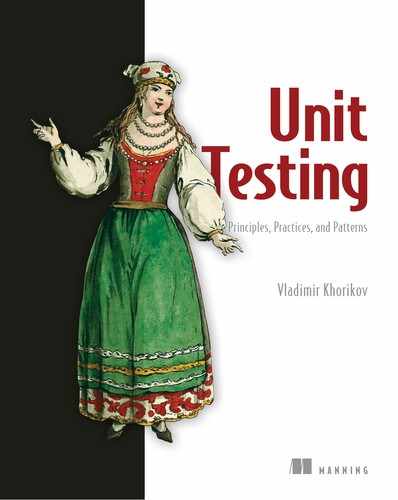Table of Contents
Chapter 1. The goal of unit testing
1.1. The current state of unit testing
1.3. Using coverage metrics to measure test suite quality
1.3.1. Understanding the code coverage metric
1.3.2. Understanding the branch coverage metric
1.4. What makes a successful test suite?
1.4.1. It’s integrated into the development cycle
1.4.2. It targets only the most important parts of your code base
1.4.3. It provides maximum value with minimum maintenance costs
Chapter 2. What is a unit test?
2.1. The definition of “unit test”
2.2. The classical and London schools of unit testing
2.2.1. How the classical and London schools handle dependencies
2.3. Contrasting the classical and London schools of unit testing
2.3.1. Unit testing one class at a time
2.3.2. Unit testing a large graph of interconnected classes
2.3.3. Revealing the precise bug location
2.3.4. Other differences between the classical and London schools
2.4. Integration tests in the two schools
Chapter 3. The anatomy of a unit test
3.1. How to structure a unit test
3.1.2. Avoid multiple arrange, act, and assert sections
3.1.3. Avoid if statements in tests
3.1.4. How large should each section be?
3.1.5. How many assertions should the assert section hold?
3.1.6. What about the teardown phase?
3.1.7. Differentiating the system under test
3.1.8. Dropping the arrange, act, and assert comments from tests
3.2. Exploring the xUnit testing framework
3.3. Reusing test fixtures between tests
3.3.1. High coupling between tests is an anti-pattern
3.3.2. The use of constructors in tests diminishes test readability
3.5. Refactoring to parameterized tests
3.6. Using an assertion library to further improve test readability
2. Making your tests work for you
Chapter 4. The four pillars of a good unit test
4.1. Diving into the four pillars of a good unit test
4.1.1. The first pillar: Protection against regressions
4.1.2. The second pillar: Resistance to refactoring
4.1.3. What causes false positives?
4.1.4. Aim at the end result instead of implementation details
4.2. The intrinsic connection between the first two attributes
4.2.1. Maximizing test accuracy
4.2.2. The importance of false positives and false negatives: The dynamics
4.3. The third and fourth pillars: Fast feedback and maintainability
4.4. In search of an ideal test
4.4.1. Is it possible to create an ideal test?
4.4.2. Extreme case #1: End-to-end tests
4.4.3. Extreme case #2: Trivial tests
4.5. Exploring well-known test automation concepts
Chapter 5. Mocks and test fragility
5.1. Differentiating mocks from stubs
5.1.1. The types of test doubles
5.1.2. Mock (the tool) vs. mock (the test double)
5.1.3. Don’t assert interactions with stubs
5.2. Observable behavior vs. implementation details
5.2.1. Observable behavior is not the same as a public API
5.2.2. Leaking implementation details: An example with an operation
5.2.3. Well-designed API and encapsulation
5.2.4. Leaking implementation details: An example with state
5.3. The relationship between mocks and test fragility
5.3.1. Defining hexagonal architecture
5.3.2. Intra-system vs. inter-system communications
5.3.3. Intra-system vs. inter-system communications: An example
5.4. The classical vs. London schools of unit testing, revisited
5.4.1. Not all out-of-process dependencies should be mocked out
Chapter 6. Styles of unit testing
6.1. The three styles of unit testing
6.1.1. Defining the output-based style
6.2. Comparing the three styles of unit testing
6.2.1. Comparing the styles using the metrics of protection against regressions and feedback speed
6.2.2. Comparing the styles using the metric of resistance to refactoring
6.2.3. Comparing the styles using the metric of maintainability
6.3. Understanding functional architecture
6.3.1. What is functional programming?
6.4. Transitioning to functional architecture and output-based testing
6.4.1. Introducing an audit system
6.4.2. Using mocks to decouple tests from the filesystem
6.5. Understanding the drawbacks of functional architecture
Chapter 7. Refactoring toward valuable unit tests
7.1. Identifying the code to refactor
7.1.2. Using the Humble Object pattern to split overcomplicated code
7.2. Refactoring toward valuable unit tests
7.2.1. Introducing a customer management system
7.2.2. Take 1: Making implicit dependencies explicit
7.2.3. Take 2: Introducing an application services layer
7.2.4. Take 3: Removing complexity from the application service
7.3. Analysis of optimal unit test coverage
7.3.1. Testing the domain layer and utility code
7.4. Handling conditional logic in controllers
7.4.1. Using the CanExecute/Execute pattern
7.4.2. Using domain events to track changes in the domain model
Chapter 8. Why integration testing?
8.1. What is an integration test?
8.1.1. The role of integration tests
8.2. Which out-of-process dependencies to test directly
8.2.1. The two types of out-of-process dependencies
8.2.2. Working with both managed and unmanaged dependencies
8.2.3. What if you can’t use a real database in integration tests?
8.3. Integration testing: An example
8.3.1. What scenarios to test?
8.3.2. Categorizing the database and the message bus
8.4. Using interfaces to abstract dependencies
8.4.1. Interfaces and loose coupling
8.5. Integration testing best practices
8.5.1. Making domain model boundaries explicit
8.5.2. Reducing the number of layers
8.6. How to test logging functionality
8.6.1. Should you test logging?
8.6.2. How should you test logging?
Chapter 9. Mocking best practices
9.1.1. Verifying interactions at the system edges
9.2.1. Mocks are for integration tests only
9.2.2. Not just one mock per test
Chapter 10. Testing the database
10.1. Prerequisites for testing the database
10.1.1. Keeping the database in the source control system
10.1.2. Reference data is part of the database schema
10.2. Database transaction management
10.3.1. Parallel vs. sequential test execution
10.4. Reusing code in test sections
10.4.1. Reusing code in arrange sections
10.4.2. Reusing code in act sections
10.4.3. Reusing code in assert sections
10.4.4. Does the test create too many database transactions?
10.5. Common database testing questions
Chapter 11. Unit testing anti-patterns
11.1. Unit testing private methods
11.1.1. Private methods and test fragility
11.3. Leaking domain knowledge to tests
11.5. Mocking concrete classes
